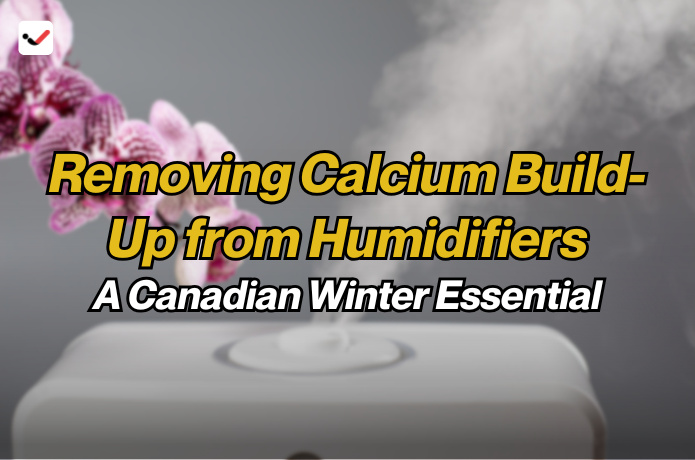Removing Calcium Build-Up from Humidifiers: A Canadian Winter Essential
Removing Calcium Build-Up from Humidifiers: A Canadian Winter Essential

Winter in Canada is known for its biting cold, heavy snowfall, and dry indoor air. To combat the dryness, many Canadian households rely on humidifiers to maintain comfortable moisture levels, which help prevent issues like dry skin, irritated sinuses, and cracked furniture. However, frequent use of humidifiers, especially with hard water, often leads to calcium build-up, also known as limescale. This white, chalky residue not only reduces the efficiency of the humidifier but can also pose health concerns by releasing mineral particles into the air.
Maintaining your humidifier is crucial to ensure clean, moist air circulates in your home. Removing calcium deposits is an essential part of this maintenance. In this guide, we’ll explore why calcium build-up occurs, its potential impact, and simple, effective ways to clean and prevent it. With these tips, you can keep your humidifier running smoothly all winter long.
Understanding Calcium Build-Up in Humidifiers
Calcium build-up occurs when hard water, which contains high levels of calcium and magnesium minerals, evaporates in the humidifier. The leftover minerals form a stubborn, chalky residue on the interior surfaces of the humidifier, such as the water tank, filter, and heating elements. Over time, this residue can clog the humidifier, reduce its efficiency, and lead to unpleasant odors or white dust.
While many Canadian households use tap water in their humidifiers, doing so increases the risk of limescale accumulation. Hard water is common in Canada, particularly in areas like Ontario and the Prairies. Using distilled or demineralized water can significantly reduce this problem. However, if calcium deposits have already formed, regular cleaning is essential to restore your humidifier’s performance.
The Impact of Calcium Build-Up on Your Home and Health
Ignoring calcium build-up can lead to more than just a malfunctioning humidifier. The residue can promote the growth of bacteria and mold, which may be released into the air, causing respiratory issues or aggravating allergies. Additionally, white dust created by mineral particles can settle on furniture and electronics, requiring extra cleaning and maintenance.
From a financial perspective, a poorly maintained humidifier may wear out faster, leading to costly replacements. Regular care, including removing calcium deposits, helps extend the life of your humidifier and ensures your home remains a healthy and comfortable environment during the cold Canadian winters.
Simple Steps to Remove Calcium Build-Up
Cleaning your humidifier doesn’t have to be a daunting task. With the right tools and methods, you can efficiently remove calcium deposits and restore your humidifier to optimal performance. Here are some easy steps to follow:
1. Turn Off and Unplug the Humidifier
For safety, always ensure your humidifier is turned off and unplugged before cleaning. Empty any remaining water from the tank.
2. Disassemble the Parts
Remove the water tank, filter, and any detachable components. Check the manufacturer’s instructions for guidance on disassembly.
3. Soak in a Vinegar Solution
Fill a basin with equal parts white vinegar and water. Soak the affected parts, such as the water tank and base, in the solution for 30-60 minutes. Vinegar is a natural descaling agent that effectively dissolves calcium deposits.
4. Scrub Away Residue
Use a soft brush, sponge, or cloth to gently scrub away loosened deposits. Avoid using abrasive materials that could damage the humidifier’s surfaces.
5. Rinse Thoroughly
Rinse all components with clean water to remove vinegar residue. Pay extra attention to the water tank and base, as leftover vinegar can affect the humidifier’s operation.
6. Dry Completely
Allow all parts to air dry before reassembling the humidifier. This step prevents mold or bacteria from developing in damp areas.
7. Replace Filters if Necessary
If your humidifier uses a filter, check for signs of wear or damage. Replace it as needed to maintain optimal performance.
Preventing Calcium Build-Up in the Future
Prevention is the key to reducing calcium deposits and prolonging your humidifier’s lifespan. Here are some tips to keep your humidifier clean and efficient:
Use Distilled or Demineralized Water
Unlike tap water, distilled or demineralized water contains minimal minerals, significantly reducing limescale formation. Although it may cost more upfront, it can save you time and effort in cleaning.
Clean Regularly
Make it a habit to clean your humidifier at least once a week during heavy use. Frequent cleaning prevents residue from hardening, making it easier to remove.
Empty and Dry Daily
After each use, empty the water tank and dry the humidifier. This simple step helps minimize mineral build-up and inhibits bacterial growth.
Invest in a Humidifier with Built-In Filters
Some modern humidifiers are equipped with filters designed to reduce mineral content. While these models may be pricier, they offer the added benefit of lower maintenance.
Choosing the Right Products for Cleaning
For those looking for alternatives to vinegar, there are specialized descaling solutions available on the market. These products are formulated to remove calcium deposits safely and effectively without damaging your humidifier. Always check the label to ensure compatibility with your device.
Baking soda is another natural option for cleaning. Combine it with water to form a gentle paste, which can be used to scrub stubborn limescale deposits. Baking soda is also effective at neutralizing odors.
Maintaining Your Humidifier: A Worthwhile Effort
Taking care of your humidifier by removing calcium build-up ensures it operates efficiently throughout the Canadian winter. Clean, moist air contributes to better health, improved comfort, and a longer lifespan for your device. By following the steps outlined above and adopting preventive measures, you can keep your humidifier in excellent condition and enjoy a cozy home environment all season long.
Remember, a well-maintained humidifier is more than just an appliance—it’s a vital tool for creating a healthier, more comfortable living space during Canada’s harsh winter months. By making regular cleaning a priority, you’ll reap the benefits of improved air quality and prolonged humidifier performance.

